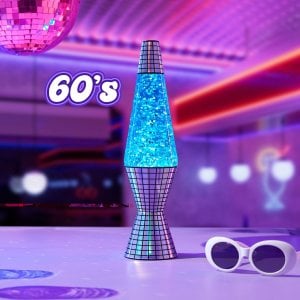This 60-year-old ‘ugly’ lamp is making waves again!
When you think of the 1960s, what pops into your head?
Perhaps it’s the vibrant counterculture movements, marked by peace signs, Woodstock, and anti-war protests. Or maybe it’s the British music invasion, with bands like The Beatles and The Rolling Stones taking the world by storm.
The ‘60s was a decade of groundbreaking changes, psychedelic art, and a passionate belief in a brighter tomorrow.
Amidst all these cultural changes, there was something else that became very famous, and it captured the spirit of the time with its colourful and surreal style: the lava lamp.
Known for its bright colours, the lava lamp was a popular fixture in many homes—and many are still around today. These lamps were even seen in TV shows like Doctor Who.
This month, the ‘60s icon is celebrating its 60th birthday, and to mark the occasion, famous people from fashion, art, and design, including photographer Rankin, are creating special edition designs.
The lamp has a long history. It was created by a company called Mathmos in 1963, started by Edward Craven Walker from Britain.

At one point, the company sold up to 7 million lamps in a year—but like all popular things, sales went down over time.
In the mid-1970s, they were selling only 10,400 lamps a year as new designs and trends took over the market.
However, the 1980s saw a return to 1960s styles, and the lava lamp became popular again.
How does the lamp work?
The lamp operates by heating wax suspended in warm liquid.
When the lamp’s bulb heats the mixture, the wax melts, rises, cools, and sinks, creating a continuous cycle.
The lamp’s unique design was inspired by rocket-shaped bottles, and they are still handmade in Poole, Dorset, using a secret ‘lava’ formula.
Video source: Facebook/@lavalamp
Edward Craven Walker described it as a cycle of life: ‘It’s like the cycle of life. It grows, breaks up, falls down, and then starts all over again.’
An original lamp costs £85 ($162.70 AUD), but cheaper imitations are available. These lamps are built to last, and the company offers replacement parts as needed.

Members, who among you here have had a lava lamp? Do you still own one? Share your views in the comments below!
Perhaps it’s the vibrant counterculture movements, marked by peace signs, Woodstock, and anti-war protests. Or maybe it’s the British music invasion, with bands like The Beatles and The Rolling Stones taking the world by storm.
The ‘60s was a decade of groundbreaking changes, psychedelic art, and a passionate belief in a brighter tomorrow.
Amidst all these cultural changes, there was something else that became very famous, and it captured the spirit of the time with its colourful and surreal style: the lava lamp.
Known for its bright colours, the lava lamp was a popular fixture in many homes—and many are still around today. These lamps were even seen in TV shows like Doctor Who.
This month, the ‘60s icon is celebrating its 60th birthday, and to mark the occasion, famous people from fashion, art, and design, including photographer Rankin, are creating special edition designs.
The lamp has a long history. It was created by a company called Mathmos in 1963, started by Edward Craven Walker from Britain.

The lava lamp: an ultimate icon of kitsch from an era when bright orange was the norm and avocado bathroom suites were chic. Image source: Facebook/@LavaLamp
At one point, the company sold up to 7 million lamps in a year—but like all popular things, sales went down over time.
In the mid-1970s, they were selling only 10,400 lamps a year as new designs and trends took over the market.
However, the 1980s saw a return to 1960s styles, and the lava lamp became popular again.
How does the lamp work?
The lamp operates by heating wax suspended in warm liquid.
When the lamp’s bulb heats the mixture, the wax melts, rises, cools, and sinks, creating a continuous cycle.
The lamp’s unique design was inspired by rocket-shaped bottles, and they are still handmade in Poole, Dorset, using a secret ‘lava’ formula.
Video source: Facebook/@lavalamp
Edward Craven Walker described it as a cycle of life: ‘It’s like the cycle of life. It grows, breaks up, falls down, and then starts all over again.’
An original lamp costs £85 ($162.70 AUD), but cheaper imitations are available. These lamps are built to last, and the company offers replacement parts as needed.
Key Takeaways
- This 60-year-old lava lamp is making a trendy comeback, known for its unique design.
- The lamp's history includes its origins in the 1960s, a decline in sales, and a resurgence in the 1980s.
- It operates by heating wax in warm liquid, creating a mesmerising cycle.
- Edward Craven Walker's description of it being a cycle of life captures its enduring charm.







